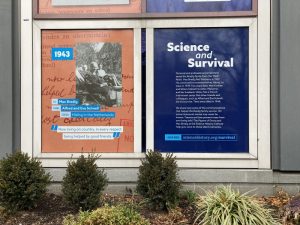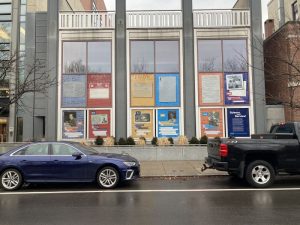
If asked to conjure an image of a Jewish German scientist who came to America to escape Nazi clutches, many think of Albert Einstein. But his isn’t the only story that matches the description.
In 1940, German chemist Georg Bredig arrived in the U.S., three years after his son Max Bredig fled Nazi Germany and laid the groundwork for his family’s escape. A network of scientists around the world helped the family make their voyage. The Bredig family’s story, complete with letters and photographs, is on display in “Science and Survival,” an outdoor exhibit on the facade of the Science History Institute in Old City. The exhibit runs through April 25.
“It’s a story of victimization and a premature, forced ending of [Georg’s] career,” said Jocelyn McDaniel, research curator of the Bredig Project at the Science History Institute. “But then he also knew that there was hope, in either Israel or the United States and, that one day, his legacy might be shown or his work might be valuable for scientists in the future.”
Bredig was born in Prussia, in what is now western Poland, in 1868 to a middle-class German-speaking family. After studying at Berlin’s Friedrich-Wilhelm University, Bredig went on to become a physical chemist in a time when the field was just taking off and when Germany was at the center of this age of scientific innovation.
The young scientist was the protege of Nobel Prize winners and exchanged letters with Einstein and Nobel Prize winner Johannes Stark, among other scientists. Bredig is best known for his arc method, a type of colloidal chemistry still used today.
Despite his renown, Bredig’s career abruptly halted in the 1930s, when the 1933 Law for the Restoration of the Professional Service and 1935 Nuremberg Race Laws stripped many German Jews of their right to work, travel and own land. Bredig lost his professorship at the Technical University of Karlsruhe, and his passport was marked with a “J.” The death of his mother just months before only made matters worse.
Despondent and growing hopeless, Bredig sent a letter to the Daniel Sieff Research Institute, in what was then the British Mandate of Palestine, with his scientific research, asking them to accept and preserve the collection. They accepted.

“He did save all of his papers, which is amazing,” McDaniel said. “And he sensed that as well. He mentioned in a lot of the letters that he knew the dangers that would come, so he wanted to preserve his legacy.”
With the help of his connections in the field, Max Bredig was able to find a professorship at the University of Michigan in 1937. Along with international colleagues, Max Bredig helped his father immigrate from the Netherlands after he fled Germany to the U.S. after securing a lectureship for Georg Bredig at Princeton University. Bredig accepted the position in 1939.
“I venture to convey my heartiest thanks to you and the Department of Chemistry for the great honor and kindness bestowed upon me by the invitation to come to your illustrious university,” Bredig wrote in a letter. “Be sure that I shall endeavour to be worthy of it.”
Concurrently, Max Bredig was also able to help his sister and brother-in-law Marianne and Viktor Homburger, as well as their daughter, escape from a French concentration camp.
Georg Bredig died in 1944 and never lectured at Princeton, but his scientific legacy was preserved elsewhere. George Bredig, son of Max Bredig, found the collection in his father’s basement and recognized the collection’s value after viewing letters from Bredig’s mentors, including many Nobel Prize winners. In 2019, the Scientific History Institute acquired the Papers of Georg and Max Bredig, a collection of over 2,500 objects.
Though a small series of photos, letters and descriptions are displayed outside of the museum, the rest of the 21-linear-foot collection is available to researchers. Detailing a story of an unlikely survival, the Papers of Georg and Max Bredig should be widely available, according to Patrick Shea, Science History Institute’s chief curator of manuscripts and archives.
“The very existence of it is pretty unique,” Shea said. “Certainly it might be more common to find in European archives, but just a collection that was pretty much created pre-Nazi Germany and during Nazi Germany — it made it out during the war years. A lot of that material in similar collections were confiscated by the Nazis and just burned. Entire libraries no longer exist because of Nazi policies.”
For more information about the collection, visit sciencehistory.org/science-and-survival.






